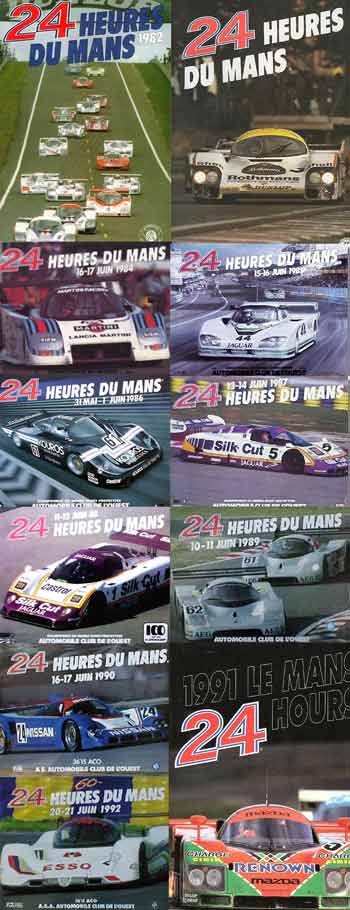| The 1980's 2 events spurred a new era in Sportscar racing, in Europe FISA introduced its 'Group C' regulations for the new World Endurance Cup and in the USA, IMSA updated the regulations of their GTP(rototype) class. The result of their efforts was a very sucessful revival of prototype endurance racing on both sides of the Atlantic that would last for almost a decade. Group C History: the rise and fall of sportsprototypes 1982 - 1994
With the advent of ground effects and new materials such as carbon fiber, the new breed of sportscars would reach over 400km p/hr on the straights, whilst possessing ground-hugging capacity in the corners. As usual the main podium for these cars would be Le Mans.
The rise: 1982 - 89 Group C rules removed restrictions on engine capacity, using fuel consumption to homologate cars instead. It's goal was to lure back manufacturers, even performance, and provide good racing. Essentially, anything went in terms of engines, provided you could get them to run through a race on a limited amount of fuel.(600 l for 1,000-km races, 2,600 l for the LM 24 Hrs).  This allowed production engines like the Aston and Mercedes V8s and Jaguar V12s to compete head to head with Mazda's rotary engines and Ford's Cosworth V8s. This allowed production engines like the Aston and Mercedes V8s and Jaguar V12s to compete head to head with Mazda's rotary engines and Ford's Cosworth V8s.
As in previous era's, Porsche led the way by designing the immortal 956/962 which dominated the first half of the decade.
In these early years Porsche's main protagonists were Lancia and to a lesser extent specialist chassis makers like Lola, March, Rondeau and WM.
It didn't take long before it was clear that if you wanted to win you had to drive a Porsche. As a result many teams without manufacturer backing turned to Zuffenhausen and siggen a customer deal. This program was so succesfull that by 1985 the main opposition to the works team were the customer Porsches.
By the late eighties the series had grown in both popularity and level of competition. Fans were treated to the sight and sounds of Jaguar racing against Mercedes against Porsche and the massed ranks of the Japanese manufacturers (notably Mazda, Nissan and Toyota).
...and fall : 1990-94
After 8 years of stability FISA introduced several rule changes that would change the face of Prototype racing once again. The 1000km races
and fuel limitation rules were scrapped in favor of 480Kms sprints and a new engine formula of (F1 derived) non turbo 3,5 l engines. As a motivation to build cars to the new (C1) specifications, the older (C2) cars were handicapped by increasing min. weight and stricter fuel allocations.
These measures were intended to open the series to more manufacturers but as it turned out, they resulted in the opposite. Porsche was one of the first manufactures to withdraw from the series, even advising its customer teams to do the same. Jaguar and Mercedes did buildt cars for the new 3.5 l formula but, as these were pure sprint machines, they never raced them at Le Mans.
In fact the only new entry was Peugeot which would dominate the remaining years with the 905. The last generation of Group C's was spectacular, high tech and blindingly fast but immensly expensive as well. One by one the manufacturers dropped out, and when the old turbo cars were finally banned, so did the customer teams.
They say you only need 2 horses to have a race, and true Peugeot (905) and Toyota (Ts 010) did put up some fierce the battles at la Sarthe. But to the FIA one race was not enough to support a World series and pulled the plug by the and off 1993.
The final race featuring (old) Group C cars was at Le Mans in 1994, when Toyota came back, for a last hurrah, but they were narrowly beaten by the new 'GT' Dauer Porsche 962C (a street legal Group C car running on narrow tyres without ground effect). Perhaps, looking back over the Group C era, this was poetic justice...
The development of 12 years of Gr C as illustrated by LM posters
|

